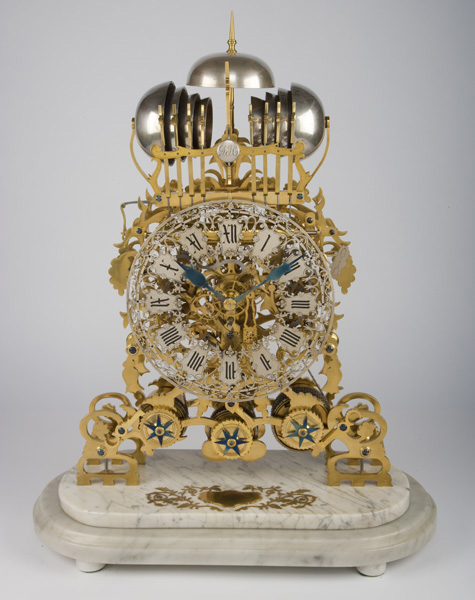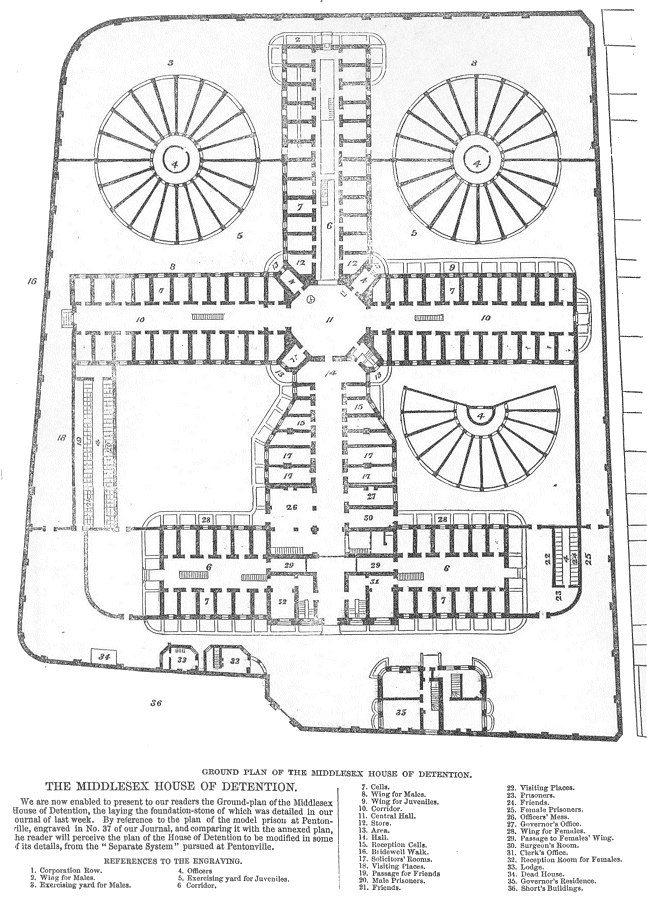Yesterday, lazily wondering what the premise might be for the last mystery in my trilogy, I decided I wanted a character held in prison awaiting trial while my protagonist runs around London trying to clear him of the charge of . . . well, I don’t know yet. Having already set the first mystery in Southwark, and the second around Holborn, I was cruising around Clerkenwell because I wanted to get a little more East End-ish but not go all out Dickensonian. I’m thinking 1870. Maybe my guy should be accused of stealing this clock (Clerkenwell was known for clock-making):

I knew the infamous Coldbath Fields prison was in the area, because I have a previous character in prison there for debt, but I was seeking not a prison but a gaol, a place where they hold people until they go to trial.( I’ve seen too many Father Brown episodes to want my character rescued after he’s been convicted — it’s way too complicated.) And there seemed to be one in the area, but it took a lot of searching to get it all separated from Coldbath Fields and the other prison buildings that had been on the same property before. As one website tried to explain it:
Clerkenwell (old) Prison, also known as the Clerkenwell House of Detention or Middlesex House of Detention was a prison in Clerkenwell, London, opened in 1847. It held prisoners awaiting trial. It stood on Bowling Green Lane conveniently close to the Middlesex Sessions House, where prisoners would be tried, on Clerkenwell Green to the south.
Well that helped with location, anyway. Then it goes on:
The House of Detention was built on the site of two earlier prisons, the Clerkenwell Bridewell for convicted prisoners and the New Prison for those awaiting trial. The Bridewell closed in 1794 and its functions were taken over by the Coldbath Fields Prison at Mount Pleasant. The New Prison was rebuilt in 1818 and in 1847, at which time its name changed to the House of Detention.
Confused? Me too. Was it the Middlesex House of Corrections? No, I think that’s Coldbath Fields. House of Detention? Why isn’t anyone calling it a gaol? So Dickens Junior, ever the tour guide, decided to help out, via this page:
House of Detention —affectionately termed by the “profession” the House of Distinction, or more familiarly “the Tench “—is designed primarily for untried prisoners, the discipline being less severe than elsewhere. Prisoners under short sentence of imprisonment without hard labour—technically first-class misdemeanants — are also confined here; being not required to wear any distinctive dress or to have their hair cropped. It stands between Woodbridge-street and Rosoman-street, Clerkenwell. NEAREST Railway Station, Farringdon-street; Omnibus Routes, Exmouth-street and Goswell-road; Cab Rank,Clerkenwell-green.
– Charles Dickens (Jr.), Dickens’s Dictionary of London, 1879
I also started coming across the floor plan, which made it easier to identify.

One ghost tour also calls it the House of Detention. By this point, I’m pretty sure I have the right place. And look! It’s still kind of there, though it’s called Clerkenwell Prison.
The Old Sessions House was the Middlesex Sessions House, where the cases were taken for trial, so that helps too.
I even found some engineering information. (And this, children, is why I abandoned studying medieval technology for Victorian England, where there are a fabulous number of sources, all in English and none of them copyrighted.)
This picture kept coming up as I worked, claiming to be visiting hours at Clerkenwell prison, but I was unable to verify if this was the place I wanted.
It looks so nice, all the visitors talking to their friends and loved ones in the door holes. But is this the place? I start looking, as one does, at the Illustrated London News, but no. After doing image search and finding the image on Wikipedia, which does occasionally cite sources, it appears it’s not from the Illustrated London News (or the “Chronicle” as noted on another page), but from Henry Mayhew’s The Criminal Prisons of London, and Scenes of Prison Life (1862). Stupidly, I go looking at Biblio.com and other vendors to buy it ($65!) only to find the whole book, downloadable for free, at Google Books. (Every time I start to yell at Google for being a monstrosity, they do something nice.)
And in that book was everything: not just the image but what kind of prisoner went in what sort of cell, what furniture was in each cell, where the windows were, what sorts of crimes people were in for, and even a menu:
I don’t think it’s right that if he’s there for three months he doesn’t get a pint of cocoa, but no one asked me. Or Mr Mayhew.
After 24 hours, I have a place! And then something serendipitous happened. I was having trouble finding something to watch on the Roku during my exercises when BritBox conked out, so I started watching the film The Guernsey Literary and Potato Peel Pie Society (I have been waiting till it was long enough after reading it to see the movie). There’s a scene in a jazz club, and I’m thinking, that looks like Clerkenwell Prison. But of course I’ve got Clerkenwell Prison on the brain, and so I look it up and what do you know: that’s where it was filmed, in the cellar. You can go there and visit the cellar, which didn’t get destroyed in the Blitz, or even hire it for events.


